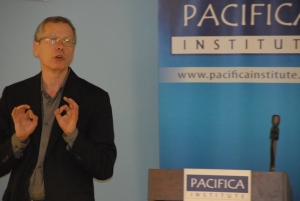Dr. Gelvin began his talk by stating the demographical and geographical characteristics of Syria and illustrated how nearly 1.7 million people had to move out from their homes to neighboring countries such as Turkey, Jordan and the rest of the world. Dr. Gelvin mentioned that what we see in Syria is the leftover effect of the Arab uprising which started in Tunisia. He quoted from Bashar al Assad’s’ speech in the Wall Street Journal, which mainly states that the Syrian uprising is quite different than the rest of the Arab world in that the Syrian uprising has more ideological roots than the rest of the world. Syria has the Sunni, Shiite, Kurd, Hezbollah, PKK, and the Hamas effect within its borders which create severe ideological clashes. He also mentioned the possible picture of fragmentation in Syria after the war reached an end. Dr. Gelvin also mentioned the fact that, in Syria, we do not see the outside powers that we were able to see in the Yemen and Libya cases. This could be related to the political and demographic construction is Syria. Dr. Gelvin also emphasized the military actions taken against government protests. To illustrate, he pointed out that the protests were usually held during the nighttime, since Syrian military does not have enough snipers with night viewer. This also causes a lot of concern regarding the most current picture in Syria.
One member of the audience asked Dr. Gelvin whether he trusts what he hears on the news. He replied by saying, “I do not know about that but press can lie, each party lies, this is the way politics works.” He suggested to another member of the audience that was planning to go to Syria not to do so since it was not a good time to go to there, even though that was the best way to learn what really is going on. He ended his speech by stating the fact that in order to stop the violence in Syria, The US, Russian, Iranian and Syrian governments have to come to a common conclusion, adding that he hoped that this was not the fragmentation of Syria.

